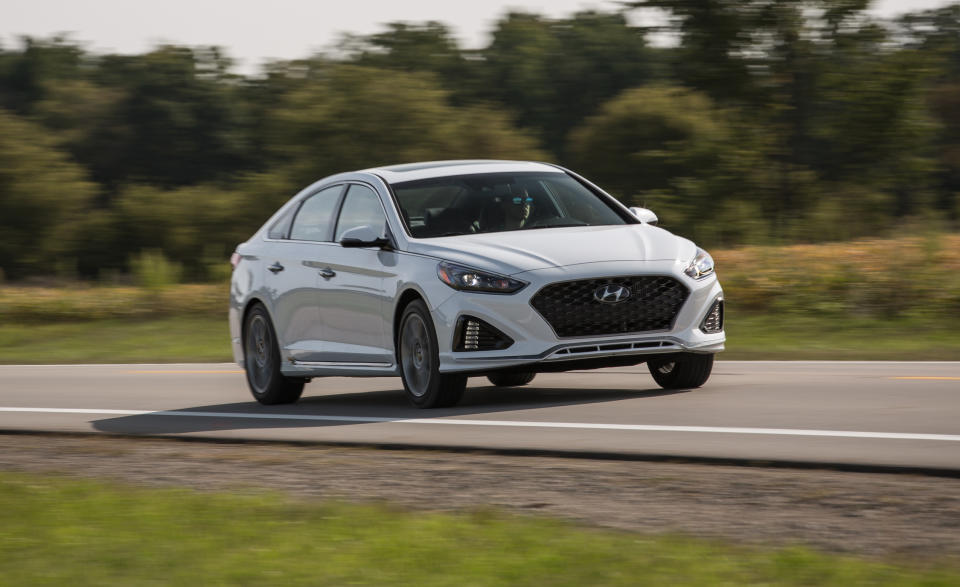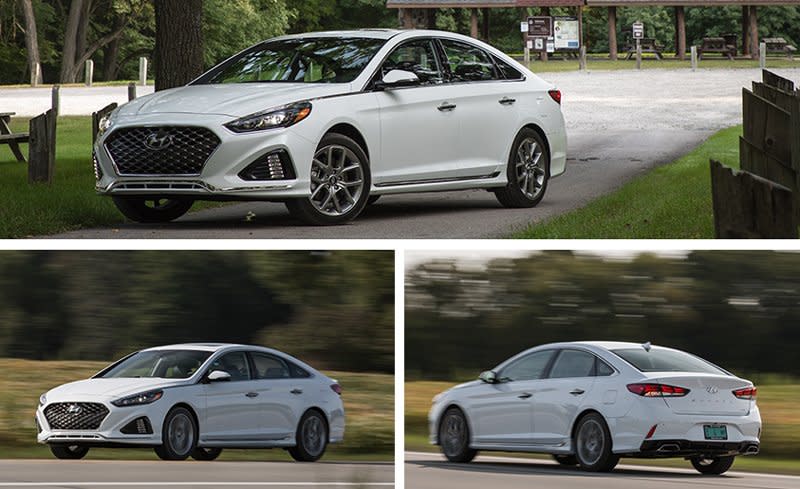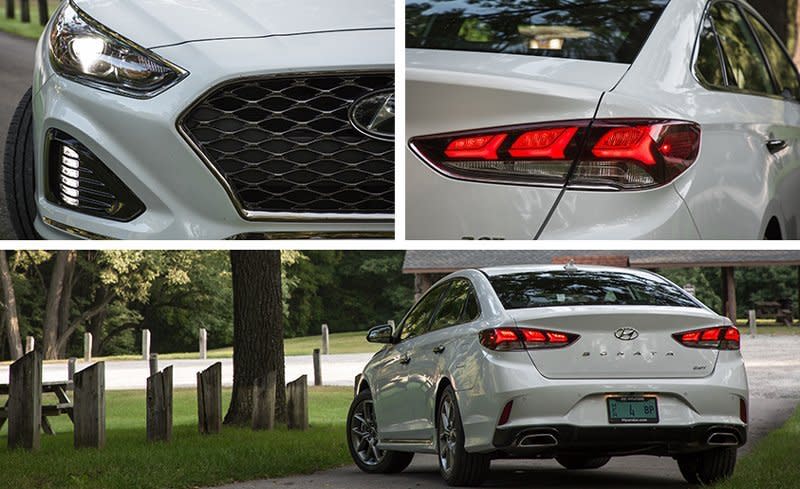2018 Hyundai Sonata 2.0T

Consumer tastes may be shifting from cars to crossovers these days, but 2018 is proving to be a watershed year for the mid-size family sedan, starting with all-new, vastly improved versions of the two top sellers: the Toyota Camry and the Honda Accord. Hyundai also is bringing a refreshed version of its seventh-generation Sonata, tested here in its most powerful and luxurious 2.0T Limited form.
With its fresh styling and sundry improvements inside—as well as a new eight-speed automatic transmission for its most powerful engine, the turbocharged 2.0-liter inline-four—the Sonata strikes many a nice note. But it’s still a beat behind the class leaders, less because of any particular flaw than the sheer fact that the Accord (and the Camry and the Mazda 6, among others) also keep jazzing up their tunes.

More than a Nose Job
When the current-generation Sonata launched for 2015, its styling was largely received with a collective “meh.” To be fair, the swoopy sixth-generation Sonata was a tough act to follow, but whereas that model evoked the Mercedes-Benz CLS to great effect, the 2015 model’s creased sheetmetal and angular graphic elements appeared staid and emotionless.
For the 2018 model’s mid-cycle update, Hyundai has added some drama back to the Sonata’s design without going overboard. The most notable change is up front, where a protuberant hexagonal grille now consumes the lion’s share of the real estate. The 2.0T Limited gets the Sport trim’s more aggressive front and rear fascias and adds slick new LED headlamps and taillamps. The triangular outboard air intakes contain vertical strips of LED running lights that are nifty bits of design themselves. The Sonata also sports a chiseled new hood and resculpted front fenders. Out back is a smooth new trunklid and a broad, flat new bumper. The other major body panels are not new, but the considerable changes at each end make the whole car look as if it is, especially with the dark gloss treatment applied to the mesh grille, body trim, and 18-inch wheels of Sport and Limited models with the 2.0-liter engine.
Brighter in Front, Darker in Back
Less apparent but significant nonetheless are the Sonata’s cabin refinements, which were on full display in this range-topping trim level. First, call us old school, but we like the ease of operation of sensibly laid out buttons and knobs, as in this Hyundai, which now look more sophisticated with some silver finishes. The Limited’s touchscreen has grown from 7.0 to 8.0 inches, with the surrounding air vents on either side growing larger in turn. Silver “3D Tech” trim on the doors and dashboard, a flat-bottom steering wheel, blue piping and contrast stitching, and aluminum-trimmed pedals go some ways to justify this model’s $33,335 starting price, which is 50 percent higher than that of a base Sonata. However, Hyundai’s rife use of hard plastics—particularly in less obvious areas, such as inside the glovebox and armrest—means no one will mistake the Sonata Limited for a Lexus ES350.

In the rear, occupants have lots of spread-out room while sitting on the comfortable, leather-upholstered bench seat, but they are surrounded by blackness: black hard plastic front seatbacks, black door panels, black carpeting, and a black headliner—with but a small patch of the aforementioned silver trim to relieve the gloom. Not helping matters is the replacement of the panoramic sunroof that was standard on last year’s 2.0T Limited with a front-row-only sunroof. And at night, the rear dome light’s yellowish incandescent glow clashes with the cool white LEDs used up front.
Performance: Some Good News, Some Bad News
The 2.0-liter turbo four makes the same 245 horsepower and 260 lb-ft of torque as before, but, paired with a new eight-speed transmission, acceleration improves slightly. Our test car hit 60 mph in 6.8 seconds, nearly half a second quicker than a 2016 2.0T Sport model. But it still doesn’t beat the 6.7-second time of the 2015 Sonata Eco model, which uses a 178-hp, 1.6-liter turbo four. It’s also way off the current high-water mark for four-cylinder family sedans of 5.5 seconds set by the 2018 Accord with its 252-hp turbo 2.0-liter and 10-speed automatic. And despite the transmission’s wider ratio spread, the 2018 model saw no improvement in fuel economy, earning the same 23-mpg city and 32-mpg highway EPA ratings; we averaged 22 mpg overall versus 23 mpg with the previous car.
The numerous chassis tweaks can be credited with raising the handling limits without ruining the Sonata’s pleasant ride—that’s more good news. The Sonata still steers with precision but now grips dramatically better than before, registering 0.88 g at the skidpad compared with 0.82 g for the 2016 model. The bad news is that its braking distance of 173 feet from 70 mph was six feet longer than before, and is on the long side for the segment at large.

Everything Standard
Performance isn’t what brings most shoppers to Hyundai, however—value is. And this car does have a long list of amenities beyond even those we’ve already mentioned, including retractable rear-window sun shades, a premium Infinty audio system, heating for the front seats and the steering wheel, and ventilated front seats with three settings (the strongest of which is cold enough to give you frostbite). The 2.0T Limited also gets all of the Sonata’s available safety items as standard including blind-spot warning, automatic high-beams, curve-following headlamps, adaptive cruise control with stop-and-go capability, the newly added lane-keeping assist, and more.
The refreshed 2018 Sonata in unlikely to break the Camry/Accord juggernaut’s hold on the top of the sales chart, but it does look and drive better than before. It thus presents another compelling argument against customers in the sedan market “crossing over” from a sedan to a crossover.
Specifications >
VEHICLE TYPE: front-engine, front-wheel-drive, 5-passenger, 4-door sedan
PRICE AS TESTED: $33,460 (base price: $28,485)
ENGINE TYPE: turbocharged and intercooled DOHC 16-valve inline-4, aluminum block and head, direct fuel injection
Displacement: 122 cu in, 1998 cc
Power: 245 hp @ 6000 rpm
Torque: 260 lb-ft @ 1350 rpm
TRANSMISSION: 8-speed automatic with manual shifting mode
DIMENSIONS:
Wheelbase: 110.4 in
Length: 191.1 in
Width: 73.4 in Height: 58.1 in
Passenger volume: 106 cu ft
Trunk volume: 16 cu ft
Curb weight: 3515 lb
C/D TEST RESULTS:
Zero to 60 mph: 6.8 sec
Zero to 100 mph: 17.5 sec
Zero to 130 mph: 36.1 sec
Rolling start, 5–60 mph: 7.4 sec
Top gear, 30–50 mph: 3.6 sec
Top gear, 50–70 mph: 4.5 sec
Standing ¼-mile: 15.3 sec @ 94 mph
Top speed (drag limited, C/D est): 150 mph
Braking, 70–0 mph: 173 ft
Roadholding, 300-ft-dia skidpad*: 0.88 g
*stability-control-inhibited
C/D FUEL ECONOMY:
Observed: 22 mpg
EPA FUEL ECONOMY:
Combined/city/highway: 26/23/32 mpg

 Yahoo Autos
Yahoo Autos 